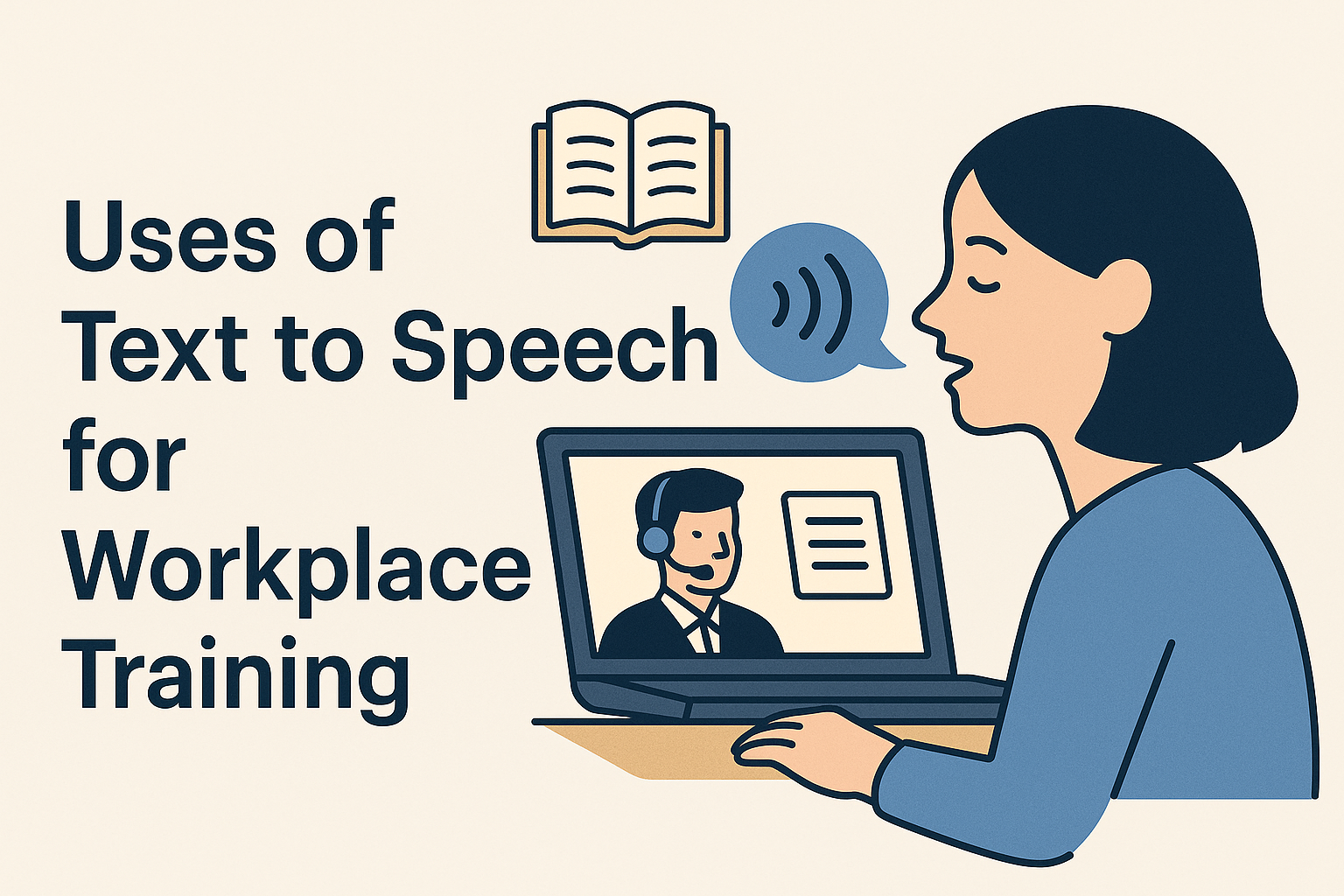Text to Speech (TTS) is transforming workplace training by making learning more engaging and accessible. Employees can listen to training modules anytime, anywhere, allowing flexibility and better retention.
TTS helps organizations deliver consistent, clear instructions across teams, supporting diverse learning styles. From onboarding new hires to upskilling experienced staff, TTS streamlines communication and enhances the overall training experience.
Modern TTS voices sound natural and professional, creating a more interactive and immersive learning environment that boosts productivity and ensures employees stay informed and confident in their roles.
Role of TTS in Workplace Training
Text-to-Speech (TTS) technology converts written text into natural-sounding audio, making workplace training more engaging and accessible. In corporate learning, it helps employees absorb content without relying only on reading, creating a smooth learning experience.
TTS supports diverse learning styles, benefiting both auditory learners and those who prefer multitasking by listening while working. Additionally, it ensures inclusivity for employees with visual impairments or reading difficulties.
In remote and hybrid training programs, TTS offers flexibility by turning training modules, presentations, and documents into audio resources employees can access anytime, anywhere, improving retention and overall training outcomes.
Key Benefits of Using TTS for Workplace Training
- Accessibility: TTS makes training content available to employees with reading difficulties, learning disorders, or visual impairments, ensuring equal participation.
- Engagement: TTS transforms training manuals, compliance guides, and policies into audio, improving concentration and retention compared to text-only learning.
- Consistency: TTS ensures every employee hears the same standardized training material, removing variation in tone, style, or emphasis.
- Multilingual Support: TTS enables training in multiple languages, allowing global teams to access content in their preferred language without delays.
Effective Strategies to Implement TTS in Training Programs
Text-to-Speech (TTS) can make training programs more engaging and accessible. One effective strategy is converting onboarding materials and standard operating procedures into audio format, making them easy to follow on the go.
Additionally, TTS can be integrated with LMS, e-learning platforms, and training videos to ensure smooth learning across devices. Furthermore, customizing voices and playback speeds allows employees to enjoy a more personalized learning experience.
Using TTS for microlearning modules and refresher courses also helps deliver short, clear lessons that improve retention and keep skills updated.
Overcoming Challenges and Maximizing TTS Effectiveness
Overcoming Challenges and Maximizing TTS Effectiveness means using text-to-speech in the smartest way to make learning clear, engaging, and easy to follow. The first step is ensuring high-quality, natural-sounding voices that feel close to real human speech, so learners stay connected.
It is also important to avoid relying only on audio, since mixing visuals, text, and sound makes understanding stronger. Furthermore, balancing TTS with interactive exercises and human feedback helps learners practice and get clarity.
Choosing the right software matters as well. Tools like Speechactors stand out because they provide lifelike voices, flexible options, and smooth integration for education and training.
Why Choose Speechactors for Workplace Training TTS Solutions

Speechactors offers high-quality, human-like voices with extensive customization including tone, speed, pitch, emotion, multiple languages and over 300 voices. Businesses can fine-tune voice output for clarity and engagement across training content.
Speechactors integrates effortlessly with corporate training platforms via its user-friendly web interface and API support, enabling seamless content conversion, MP3 export, background music mixing, and embedding into existing learning systems.
Several organizations report strong results using Speechactors for employee training, citing rapid audio production, realistic voice quality, and value reviewers describe the platform as “very happy! Their service is second to none.”
Future of TTS in Workplace Training
The future of TTS in workplace training is human sounding, adaptive, and real time. AI-driven voice models now learn prosody and intonation, delivering natural emotion, pacing, and speaker styles that approach human performance.
Emerging trends include adaptive learning, where TTS adjusts speed, vocabulary, and difficulty based on learner behavior, and real-time content conversion that turns documents, chats, and live meetings into narrated audio and captions across languages.
Next-generation corporate learning will embed TTS inside LMS and LXP workflows, support on-device or on-prem deployment for privacy, enable instant updates to policies and product knowledge, and add analytics that track comprehension and engagement.
Frequently Asked Questions (FAQs)
How can TTS improve employee training outcomes?
TTS improves training outcomes by making content more engaging, increasing knowledge retention, supporting diverse learning styles, and providing consistent delivery of training materials across different employee groups.
Is TTS effective for all types of workplace content?
TTS is effective for most workplace content such as compliance training, onboarding, and technical manuals, though interactive or highly visual content may require blended learning approaches.
Can TTS support multilingual teams?
Yes, TTS supports multilingual teams by offering natural-sounding voices in multiple languages, helping organizations deliver consistent training and communication to global employees.
How easy is it to implement Speechactors into existing LMS?
Speechactors integrates easily with most LMS platforms through API or direct file uploads, allowing seamless addition of audio content to e-learning courses.
Does TTS ensure compliance with accessibility standards?
Yes, TTS helps ensure compliance with accessibility standards like WCAG and ADA by providing audio alternatives to text for employees with visual or learning disabilities.
Conclusion
Integrating Text to Speech (TTS) in workplace training transforms learning into an engaging, accessible, and efficient experience. By leveraging clear narration, multilingual support, and interactive content, organizations can boost knowledge retention, employee confidence, and overall productivity.
Embracing TTS strategies ensures training is consistent, inclusive, and adaptable to diverse learning styles. Explore Speechactors today to elevate your workplace training, making every session more impactful, engaging, and memorable for your team.
